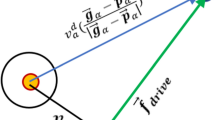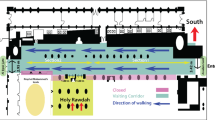Abstract
Human crowd movement flow has been studied in various disciplines such as computing science, physics, engineering, urban planning, etc., for many decades. Some studies focused on the management of big crowds in public events whereas others investigated the egress of the crowd in emergency cases. Optimal flows of a human crowd have been a particular interest among many researchers. This paper presents how various physical barricades affect human crowd movement flow using a social force model. Simulation experiments of bidirectional crowd flows were conducted with/without barricades in a straight-line street. The barricades with various lengths and rotations were tested to discover optimal flows of a crowd with various densities of the crowd. The experimental results show that setting up barricades with a particular length and rotation generates a better flow of the crowd compared to the situations without both or either of them. This study can help the management of the crowd in public events by setting up physical barricades strategically to produce optimal flows of a crowd.
Access this chapter
Tax calculation will be finalised at checkout
Purchases are for personal use only
Similar content being viewed by others
References
Blanke, U., Tröster, G., Franke, T., Lukowicz, P.: Capturing crowd dynamics at large scale events using participatory GPS-localization. In: 2014 IEEE Ninth International Conference on Intelligent Sensors, Sensor Networks and Information Processing (ISSNIP), pp. 1–7. IEEE (2014)
Farooq, M.U., Saad, M.N.B., Malik, A.S., Salih Ali, Y., Khan, S.D.: Motion estimation of high density crowd using fluid dynamics. Imaging Sci. J. 68(3), 141–155 (2020)
Granovetter, M.: Threshold models of collective behavior. Am. J. Sociol. 83, 1420–1443 (1978)
Guo, N., Hao, Q.Y., Jiang, R., Hu, M.B., Jia, B.: Uni-and bi-directional pedestrian flow in the view-limited condition: experiments and modeling. Transp. Res. Part C Emerg. Technol. 71, 63–85 (2016)
Helbing, D.: A fluid dynamic model for the movement of pedestrians. arXiv preprint cond-mat/9805213 (1998)
Helbing, D., Buzna, L., Johansson, A., Werner, T.: Self-organized pedestrian crowd dynamics: experiments, simulations, and design solutions. Transp. Sci. 39(1), 1–24 (2005)
Helbing, D., Farkas, I.J., Molnar, P., Vicsek, T.: Simulation of pedestrian crowds in normal and evacuation situations. Pedestr. Evacuation Dyn. 21(2), 21–58 (2002)
Helbing, D., Molnar, P.: Social force model for pedestrian dynamics. Phys. Rev. E 51(5), 4282 (1995)
Henderson, L.F.: On the fluid mechanics of human crowd motion. Transp. Res. 8(6), 509–515 (1974)
Hoogendoorn, S., Daamen, W.: Self-organization in pedestrian flow. In: Hoogendoorn, S.P., Luding, S., Bovy, P.H.L., Schreckenberg, M., Wolf, D.E. (eds.) Traffic and Granular Flow’03, pp. 373–382. Springer, Heidelberg (2005). https://doi.org/10.1007/3-540-28091-X_36
Hughes, R.L.: The flow of human crowds. Annu. Rev. Fluid Mech. 35(1), 169–182 (2003)
Jager, W., Popping, R., Van de Sande, H.: Clustering and fighting in two-party crowds: Simulating the approach-avoidance conflict. J. Artif. Soc. Soc. Simul. 4(3), 1–18 (2001)
Johansson, A., Kretz, T.: Applied pedestrian modeling. In: Heppenstall, A., Crooks, A., See, L., Batty, M. (eds.) Agent-Based Models of Geographical Systems, pp. 451–462. Springe r, Dordrecht (2012). https://doi.org/10.1007/978-90-481-8927-4_21
Le Bon, G.: The Crowd: A Study of the Popular Mind. Fischer, London (1897)
Macal, C.M., North, M.J.: Agent-based modeling and simulation. In: Proceedings of the 2009 Winter Simulation Conference (WSC), pp. 86–98. IEEE (2009)
Manocha, D., Lin, M.C.: Interactive large-scale crowd simulation. In: Arisona, S.M., Aschwanden, G., Halatsch, J., Wonka, P. (eds.) Digital Urban Modeling and Simulation. CCIS, vol. 242, pp. 221–235. Springer, Heidelberg (2012). https://doi.org/10.1007/978-3-642-29758-8_12
Park, A.J., Ficocelli, R., Patterson, L.D., Spicer, V., Dodich, F., Tsang, H.H.: Modelling crowd dynamics and crowd management strategies. In: 2021 IEEE 12th Annual Information Technology, Electronics and Mobile Communication Conference (IEMCON), pp. 0627–0632. IEEE (2021)
Peng, Y.C., Chou, C.I.: Simulation of pedestrian flow through a “t” intersection: a multi-floor field cellular automata approach. Comput. Phys. Commun. 182(1), 205–208 (2011)
Rozo, K.R., Arellana, J., Santander-Mercado, A., Jubiz-Diaz, M.: Modelling building emergency evacuation plans considering the dynamic behaviour of pedestrians using agent-based simulation. Saf. Sci. 113, 276–284 (2019)
Severiukhina, O., Voloshin, D., Lees, M.H., Karbovskii, V.: The study of the influence of obstacles on crowd dynamics. Procedia Comput. Sci. 108, 215–224 (2017)
Wagner, N., Agrawal, V.: An agent-based simulation system for concert venue crowd evacuation modeling in the presence of a fire disaster. Expert Syst. Appl. 41(6), 2807–2815 (2014)
Wolfram, S.: Statistical mechanics of cellular automata. Rev. Mod. Phys. 55(3), 601 (1983)
Yue, H., Guan, H., Zhang, J., Shao, C.: Study on bi-direction pedestrian flow using cellular automata simulation. Phys. A 389(3), 527–539 (2010)
Zacharias, J.: Pedestrian dynamics on narrow pavements in high-density Hong Kong. J. Urban Manag. 10(4), 409–418 (2021)
Acknowledgment
The authors would like to thank Department of Mathematical Sciences of Trinity Western University for their generous support. The authors would also like to express their gratitude for invaluable insights and feedback from their collaborators.
Author information
Authors and Affiliations
Corresponding author
Editor information
Editors and Affiliations
Rights and permissions
Copyright information
© 2023 The Author(s), under exclusive license to Springer Nature Switzerland AG
About this paper
Cite this paper
Park, A.J., Ficocelli, R., Patterson, L., Dodich, F., Spicer, V., Tsang, H.H. (2023). Effects of Various Barricades on Human Crowd Movement Flow. In: Arai, K. (eds) Proceedings of the Future Technologies Conference (FTC) 2022, Volume 1. FTC 2022 2022. Lecture Notes in Networks and Systems, vol 559. Springer, Cham. https://doi.org/10.1007/978-3-031-18461-1_32
Download citation
DOI: https://doi.org/10.1007/978-3-031-18461-1_32
Published:
Publisher Name: Springer, Cham
Print ISBN: 978-3-031-18460-4
Online ISBN: 978-3-031-18461-1
eBook Packages: Intelligent Technologies and RoboticsIntelligent Technologies and Robotics (R0)




